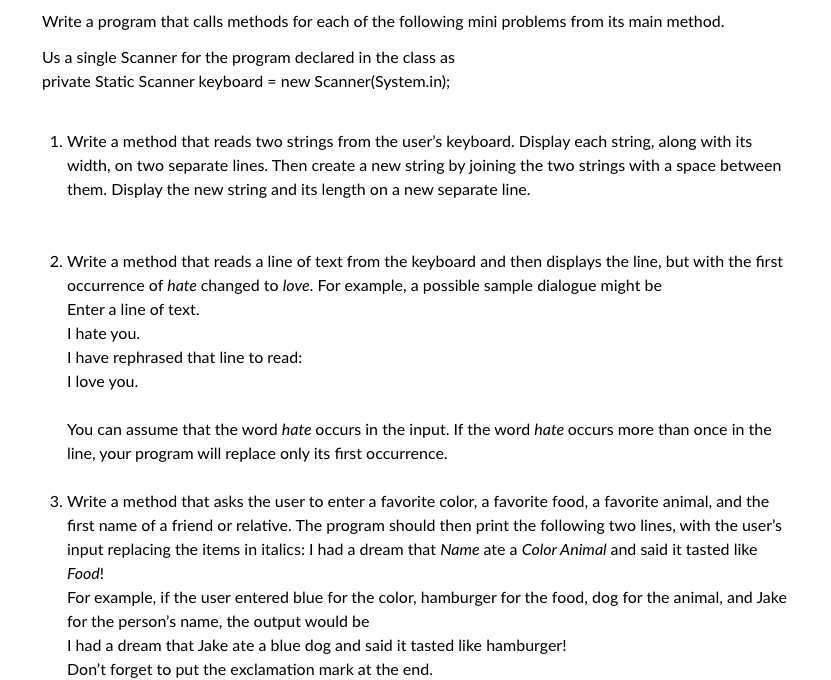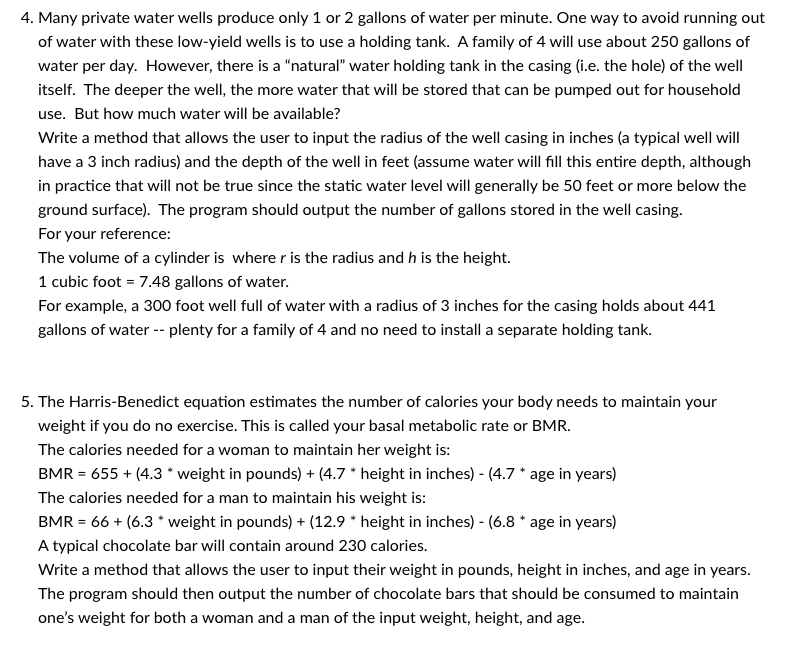6. Write a method that reads three strings from the keyboard. Although the strings are in no particular order, display the string that would be second if they were arranged lexicographically. 7. Write a method that reads a one-line sentence as input and then displays the following response: If the sentence ends with a question mark (?) and the input contains an even number of characters, display the word Yes. If the sentence ends with a question mark and the input contains an odd number of characters, display the word No. If the sentence ends with an exclamation point (!), display the word Wow. In all other cases, display the words You always say followed by the input string enclosed in quotes. Your output should all be on one line. Be sure to note that in the last case, your output must include quotation marks around the echoed input string. In all other cases, there are no quotes in the output. Your program does not have to check the input to see that the user has entered a legitimate sentence. Notes: This code requires a three-way selection statement and gives more practice with string methods. The case statement can be used since the control expression is a single character. It may be instructive to show the code using if/else, instead, and compare them for readability. 8. Write a method that reads a string from the keyboard and tests whether it contains a valid date. Display the date and a message that indicates whether it is valid. If it is not valid, also display a message explaining why it is not valid. The input date will have the format mm/dd/yyyy. A valid month value mm must be from 1 to 12 (January is 1). The day value dd must be from 1 to a value that is appropriate for the given month. September, April, June, and November each have 30 days. February has 28 days except for leap years when it has 29. The remaining months all have 31 days each. A leap year is any year that is divisible by 4 but not divisible by 100 unless it is also divisible by 400. Notes: This project provides an opportunity to introduce format checking. The solution uses case logic in combination with compound Boolean expressions. 9. Repeat the calorie counting program from problem 5 in a new method. This time ask the user to input the string “M” if the user is a man and “W” if the user is a woman. Use only the male formula to calculate calories if “M” is entered and use only the female formula to calculate calories if “W” is entered. Output the number of chocolate bars to consume as before. 10. For all of the following words, if you move the first letter to the end of the word, and then spell the result backwards you will get the original word: banana dresser grammar potato revive uneven assess Write a method that reads a word and determines whether it has this property. Continue reading and testing words until you encounter the word quit. Treat uppercase letters the same as lowercase letters. Display how many words you found when you finish. 11. You have three identical prizes to give away and a pool of 10 finalists. The finalists are assigned numbers from 1 to 10. Write a method to randomly select the numbers of 3 finalists to receive a prize. Make sure not to pick the same number twice. For example, picking finalists 3, 6, 2 would be valid but picking 3, 3, 11 would be invalid because finalist number 3 is listed twice and 11 is not a valid finalist number. For this problem you can insert the following line of code to generate a random number between 1 and 10: int num = (int) (Math.random() * 10) +1; Notes: This project uses random numbers in a loop. You might wish to introduce the Random class instead of Math.random(). 12. Suppose we can buy a chocolate bar from the vending machine for $1 each. Inside every chocolate bar is a coupon. We can redeem 6 coupons for one chocolate bar from the machine. This means that once you have started buying chocolate bars from the machine, you always have some coupons. We would like to know how many chocolate bars can be eaten if we start with N dollars and always redeem coupons if we have enough for an additional chocolate bar. For example, with 6 dollars we could consume 7 chocolate bars after purchasing 6 bars giving us 6 coupons and then redeeming the 6 coupons for one bar. This would leave us with one extra coupon. For 11 dollars, we could have consumed 13 chocolate bars and still have one coupon left. For 12 dollars, we could have consumed 14 chocolate bars and have two coupons left. Write a method that takes input for the value for N and outputs to the terminal how many chocolate bars we can eat and how many coupons we would have leftover. Use a loop that continues to redeem coupons as long as there are enough to get at least one chocolate bar.
6. Write a method that reads three strings from the keyboard. Although the strings are in no particular order, display the string that would be second if they were arranged lexicographically.
7. Write a method that reads a one-line sentence as input and then displays the following response: If the sentence ends with a question mark (?) and the input contains an even number of characters, display the word Yes. If the sentence ends with a question mark and the input contains an odd number of characters, display the word No. If the sentence ends with an exclamation point (!), display the word Wow. In all other cases, display the words You always say followed by the input string enclosed in quotes. Your output should all be on one line. Be sure to note that in the last case, your output must include quotation marks around the echoed input string. In all other cases, there are no quotes in the output. Your
Notes: This code requires a three-way selection statement and gives more practice with string methods. The case statement can be used since the control expression is a single character. It may be instructive to show the code using if/else, instead, and compare them for readability.
8. Write a method that reads a string from the keyboard and tests whether it contains a valid date. Display the date and a message that indicates whether it is valid. If it is not valid, also display a message explaining why it is not valid. The input date will have the format mm/dd/yyyy. A valid month value mm must be from 1 to 12 (January is 1). The day value dd must be from 1 to a value that is appropriate for the given month. September, April, June, and November each have 30 days. February has 28 days except for leap years when it has 29. The remaining months all have 31 days each. A leap year is any year that is divisible by 4 but not divisible by 100 unless it is also divisible by 400.
Notes: This project provides an opportunity to introduce format checking. The solution uses case logic in combination with compound Boolean expressions.
9. Repeat the calorie counting program from problem 5 in a new method. This time ask the user to input the string “M” if the user is a man and “W” if the user is a woman. Use only the male formula to calculate calories if “M” is entered and use only the female formula to calculate calories if “W” is entered. Output the number of chocolate bars to consume as before.
10. For all of the following words, if you move the first letter to the end of the word, and then spell the result backwards you will get the original word:
banana dresser grammar potato revive uneven assess
Write a method that reads a word and determines whether it has this property. Continue reading and testing words until you encounter the word quit. Treat uppercase letters the same as lowercase letters. Display how many words you found when you finish.
11. You have three identical prizes to give away and a pool of 10 finalists. The finalists are assigned numbers from 1 to 10. Write a method to randomly select the numbers of 3 finalists to receive a prize. Make sure not to pick the same number twice. For example, picking finalists 3, 6, 2 would be valid but picking 3, 3, 11 would be invalid because finalist number 3 is listed twice and 11 is not a valid finalist number. For this problem you can insert the following line of code to generate a random number between 1 and 10:
int num = (int) (Math.random() * 10) +1;
Notes: This project uses random numbers in a loop. You might wish to introduce the Random class instead of Math.random().
12. Suppose we can buy a chocolate bar from the vending machine for $1 each. Inside every chocolate bar is a coupon. We can redeem 6 coupons for one chocolate bar from the machine. This means that once you have started buying chocolate bars from the machine, you always have some coupons. We would like to know how many chocolate bars can be eaten if we start with N dollars and always redeem coupons if we have enough for an additional chocolate bar.
For example, with 6 dollars we could consume 7 chocolate bars after purchasing 6 bars giving us 6 coupons and then redeeming the 6 coupons for one bar. This would leave us with one extra coupon. For 11 dollars, we could have consumed 13 chocolate bars and still have one coupon left. For 12 dollars, we could have consumed 14 chocolate bars and have two coupons left.
Write a method that takes input for the value for N and outputs to the terminal how many chocolate bars we can eat and how many coupons we would have leftover. Use a loop that continues to redeem coupons as long as there are enough to get at least one chocolate bar.


Trending now
This is a popular solution!
Step by step
Solved in 3 steps with 2 images









